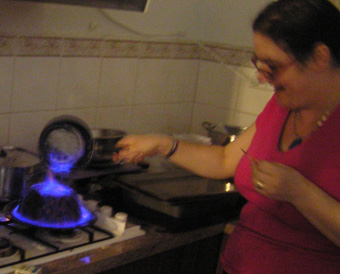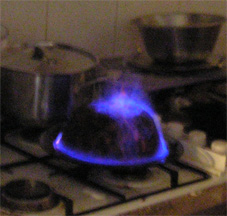I know, I know, it’s November and I’m talking about Christmas. But a traditional Christmas Pudding should be made well in advance, though mine is a fridge-dweller rather than the kind you hang off the clothes-horse to dry out. Also, of course, if you’re an Australian it always pays to take advantage of any cold snaps in late November or early December for your Christmas baking – nobody wants to stand over a pudding steamer for seven hours in 35°C weather or worse… (One of the nice things about living in Melbourne is that if you *do* like to do traditional Christmas baking, you are almost guaranteed a couple of good, cold, rainy late-November or early December weekends in which to do it.)
I’m a traditionalist in my Christmas tastes. While Christmas falls in what we like to think of as summer, this is Melbourne we’re talking about, and the weather really can do anything – I’ve had my share of ludicrously hot Christmases, but I have lived through plenty of cold, wet Christmas Days in my time (generally when we were at the beach) and one year we even managed to have snow (in the Dandenong ranges, but that’s technically part of Melbourne. Where I was, we just had hail. Lots of hail. And I had no coat or umbrella, because it had been hot when I left for choir in the morning…). That isn’t a Tall Melbourne Weather Tale, either, though I have plenty of those, too.
All of which is to say that if you are a Melbournian, a traditional roast dinner and steamed Christmas pudding is, quite frankly, just as good a bet for weather-appropriate Christmas dinner as a seafood barbecue or a selection of cold salads. Not least because you can pretty much guarantee that if you go for an all-cold Christmas meal, Melbourne will cackle wickedly and produce 15°C and hail, and you will all sit around the table feeling chilled and miserable. I’ve learned to plan Christmas dinners that can be served hot or cold, depending on the weather forecast…
(Incidentally, I happen to adore Melbourne’s meteorological waywardness, so no insulting our weather here! I wouldn’t take Sydney or Adelaide’s weather if you paid me, and as for Darwin, well, the less said about that, the better.)
Anyway, after that lengthy digression, this is my recipe for Christmas pudding. It is heavily adapted from a now-lost cookbook that may or may not have had something to do with the Country Women’s Association. On reflection, I suspect not, because they are probably traditional enough to use suet.
And now you know what I’ll be doing after choir on Sunday.
Your Shopping List
2 cups raisins
2 cups sultanas
1 1/2 cups currants (I’m thinking this year I’ll add some dried cherries here)
1 apple, grated (original has 2/3 cup chopped pitted prunes)
1 cup chopped mixed peel
finely grated rind of one lemon
1 carrot, grated coarsely (original recipe has 1/2 cup blanched almonds, chopped)
1 box of breadcrumbs from the supermarket (original recipe has 3 1/2 cups soft white breadcrumbs)
1 cup white sugar
1 cup plain flour
1/2 tspn salt (which I rarely remember to put in)
nutmeg, ginger, cinnamon, alspice, cloves – the recipe says 1 tspn mixed spice and 1/2 tspn nutmeg, but I tend to use a teaspoon or more of most of these. It’s really to taste
4 eggs
3/4 cup milk
3/4 cup brandy
1/4 cup orange juice (recipe says half cup each brandy and stout, or orange juice)
250g butter melted
Note that you can pretty much replace any fruit and nuts with others if you prefer – I replaced the peel with glace ginger for someone who didn’t like peel, for example. It’s mostly about getting wet and dry ingredients in just proportion.
Now what will you do with it?
Grease a 4 cup and an 8 cup pudding basin or steamer (the recipe says just one 8 cup one, but I always end up with more mix than that. You can also pour the remainder into a cake tin and bake it), and cut a circle of greaseproof paper to cover the bottom of the basin.
Mix together the fruit, peel, rind, carrot, apple, breadcrumbs and sugar in a truly enormous bowl. You may need to divide it between two bowls, I rarely have room in one (and this is the downsized version of the recipe…). Sift the flour, salt and spices together (like I ever bother), and add to dry ingredients. Lightly beat eggs and then add milk, brandy, juice and melted butter, and mix into the rest of the ingredients as thoroughly as possible, given that your bowl has probably overflowed.
The recipe says to ‘place the mixture in the basin’ which I think is hilarious, because what you really have to do is put a bit in, press it down as much as you can, put some more in, press down again, and so forth. Puddings are supposed to be dense, and frankly, you are not going to fit very much of your mix in the basin if you don’t really force it down. Leave 1cm at the top so it can expand a bit.
If you have a metal pudding steamer, it will clip together, but I’d use some string to tie it together too. You want to make sure there is a loop at the top which you can hook the wooden spoon through when you go to lift it out.
If you have an ordinary pudding basin with no lid, you need to get a sheet of greaseproof paper and one of foil, and lay the paper on the foil. Grease a circle on the paper which is a little bigger than the wide top of the basin. With your paper and foil together, fold them both in half (foil on the outside), and then fold the top layer back about an inch from the fold, to make a pleat. The idea is that this pleat will give the pudding room to expand. Place the paper and foil greased paper side down over the basin, and tie on with string – your basin will have a rim and you basically want the string to go tightly around that over the foil a couple of times and then be tied off – you may need someone to provide a finger to hold it in place while you tie it. Double or triple some string to make a handle, and attach each end to the circle of string around the basin. Trim the foil and paper so that there is about an inch to an inch and a half of overhang below the string.
I promise this is easier than it sounds, but if your heart fails you, check any recipe book with steamed puddings for illustrations, or check out this video – once you have seen it done once, you will have no trouble, though it helps to borrow someone’s thumb to hold the string in place while you tie it around the top of the basin (give it back afterwards – stealing people’s thumbs is not nice and definitely not in the Christmas spirit).
Get a nice big stock pot, put a trivet or an upturned (heat proof!) plate in it, and stick the pudding basin on top. Pour water carefully around the sides (or take the pudding out, pour water in, then replace the pudding to check the water level is half way to two-thirds of the way up the sides), bring water to boil, put the lid on the stock pot (to capture the steam), and boil gently for 5 hours for the large pudding and 3 hours for the smaller one. You may need to replenish the water during this time. You may find some butter gets into the water, and that’s fine – the only thing you don’t want is water getting into the steamer / pudding basin, so make sure it isn’t going too high.
On the day you go to serve the pudding, you’ll need to give it another 2 hours in the same way. I usually make the pudding a month or so in advance and store in the fridge.
I, of course, serve this with copious amounts of flaming brandy. In good years, I use so much brandy that I get a loud ‘whoomph’ on lighting and nearly set my hair on fire. One year, I nearly set the kitchen on fire, too. My German pen-friend, who had never seen a flaming pudding before, was very impressed.
The best way to achieve a flaming pudding is to heat your brandy gently on the stove until just before boiling – it will light very easily at this point, and you can pour it over already flaming, or pour it over and then flame it, though you need to be quick, before the brandy sinks in.
Or use silly amounts of brandy, which is my preferred option. If you make it flame long enough, the edges of the pudding caramelise, which is a bonus I aim for. Make sure your plate can take the heat, though.
If you are less of an alcoholic than me, it looks very pretty with a sprinkle of icing sugar ‘snow’ over the top, and if you are in Australia, redcurrants make really lovely holly berries, with mint leaves or any other edible leaf.
I serve this with cream or icecream. If you are a custard or brandy butter person, I’m afraid you will have to look elsewhere for recipes. Or maybe I’ll figure some out in the next six weeks and share them here.
The leftovers are delicious microwaved for breakfast on Boxing Day (with yoghurt to make it healthy!).
Variations
Any dried or glacé fruits or nuts would work in this, though I wouldn’t put too much glacé fruit in, for fear of making it too sweet (and the sugar potentially caramelising things). You could also add choc chips, or add cocoa powder in place of some of the flour. I wouldn’t, though – personally, I’d keep this one fruity and either make a pudding that was always designed to be full of chocolate or make chocolate truffles or my Insanely Alcoholic Christmas Chocolates (recipe will follow soon).
To make this dairy-free, you could use a non-dairy margarine or you could use suet, if you are not vegetarian. I believe suet should be grated and mixed in rather than melted. Milk can be replaced with soy milk (or almond or cashew milk might be rather fabulous), or you could just add more brandy!!! Or more orange juice, of course.
You could certainly use gluten-free flour or breadcrumbs to make this gluten-free – it’s basically a lot of dried fruit held together with the minimum amount of batter, so most gluten-free flours would work here.
Replacing the eggs is a little trickier. You basically need about 240 ml of a liquid that will help bind the pudding together, add moisture (ie, fat), and help it to expand just a little. My suspicion is a mixture of nut butter, mashed banana and baking powder would work well here, but I’d love to hear suggestions from the more experienced vegan cooks in these parts.





4 comments for “Recipe: Christmas Pudding”